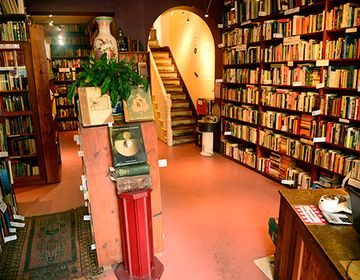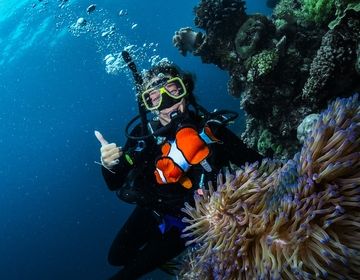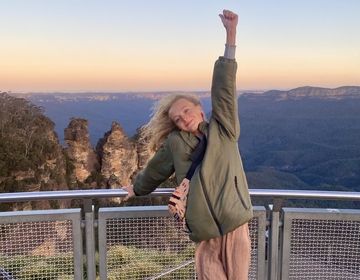Indigenous Connection to Land: The Gulaga Experience
Written by Jakob Twill from Ursinus College
On a warm Sunday morning in February, me and nine other of my CIEE Study Abroad peers pulled into a somewhat isolated parking lot in Tilba Tilba, New South Wales. We stepped out of our van with Tonia Gray, our CIEE program director and mentor for our South Coast trip. We were met by Lynne Thomas, an Aboriginal Umbarra Biripi woman and our teacher for the day. As we sat in an empty parking lot and ate our lunches, Lynne introduced us to a brief history of Mount Gulaga, or “Mother Mountain” as it is known to the peoples of the Yuin Nation, the original inhabiters of this land. Soon after, the short walk to the base of the mountain began.
Upon reaching the base of the mountain, Lynne stopped us. Here, we gathered in a circle as she introduced us to Mount Gulaga’s rich cultural history and the various ways in which Indigenous Australians have historically interacted with the land that we were standing on. She explained to us how highly Aboriginal Australians revere the land, something I have come to notice is lacking in American culture. I noted the disparity among the ways that my people and Indigenous peoples treat their land. Whereas Aboriginal Australians treat their land with the utmost respect and admiration, my people view our land as expendable- as something with which we have power over. Hearing Lynne explain the Aboriginal perspective of land and land use practice was a somewhat sobering experience for me. I could not help but think about how different our world would be if we all shared a similar perception of our land.

Shortly after our brief lesson on the historical and cultural history of Gulaga, we began our trek up the mountain. We were walking on sacred land, land that has held cultural and spiritual importance for the Aboriginal Australians of this area for thousands of years. Lynne had just recently explained to us the Aboriginal practices that were carried out on this mountain and on the surrounding mountains. Aboriginal women used the land for a type of “coming-of-age” ceremony for younger girls. However, as a whole, the mountain and surrounding land symbolized something greater. To the Aboriginal Australians of this land, the Mount Gulaga area represented a woman- a pregnant woman- and all of her children. In my mind, we were those children- the people of the Earth.
As encouraged by both Lynne and Tonia, we ascended the mountain in silence, allowing ourselves to better take in our surroundings. It was a relatively hot day and the air felt very heavy. Our legs grew tired as we maneuvered the trail towards Gulaga’s summit. We continued upwards through dense, almost tropical greenery. A feeling of absolute peace overwhelmed me during our trek up the mountain. Focused on nothing more than the greenery to my sides and the trail ahead of me, my mind wandered. My mind relapsed back to what our guide, Lynne, had explained to us before. I understood why there is such a disparity among “Indigenous” and “Colonial” perspectives of the land. Indigenous peoples have been able to develop a stronger appreciation for the land that they live upon, which has fostered an even deeper connection with it. I think that this is an appreciation that is somewhat incomprehensible to non-indigenous peoples.

After about an hour hike up Mount Gulaga, we finally reached our stopping point. We listened to a brief introduction to what we were about to experience. Then, each person in our group took turns approaching our guide Lynne. Here, she used ochre (a clay-like paint from the Earth) to paint four dots on our faces- one on each temple, one on the forehead, and one on the chin. The dot on the left side of the head symbolized sight, or seeing. It was a reminder to consciously “look” in order to take in our surroundings, both in front of and behind us. The dot on the right side of the head represents the eyes. Essentially, this dot served as a reminder to all of us to “look” at what we were going to be learning, allowing us to more clearly understand the concepts. The dots on our foreheads were our third eyes during this ceremony. Lynne explained to us that this dot was connected to our hearts and that it would help us to open up our state of consciousness to see the Earth from an alternate perspective. The last dot, the one on our chins, symbolized speaking. Lynne encouraged us to exercise deep thought before speaking, and that silence is perhaps the most important part of the ceremony. To finish off this blessing, we were all given a red string to tie around our heads, which symbolized our blood, the one thing that universally connects us all to each other.

We made our way, one by one, along a narrow path through dense trees. Out of respect, one member of our group used “clapping sticks” to signify to the spirits exactly how many of us would be entering this sacred site- one clap for each person who entered. What followed was perhaps one of the most humbling experiences of my life thus far. After Lynne continued to educate us on the Aboriginal connection to land, we all gathered around what was called the Communication Rock. Here, we stood in silence, two hands on the sacred rock, sending prayers of good fortune to those we felt needed it. During this ritual, something amazing happened- almost as if on cue, the wind that had been endlessly howling since the ceremony began suddenly stopped. All of a sudden, there was an overwhelming feeling of peace and calm as we all removed our hands from the rock and opened our eyes.
We concluded this portion of the ceremony and continued upwards along a series of steep rock faces until we reached a flat area atop one particularly large rock. Here, we sat down and listen on as Lynne educated us on the “Teaching Rocks”. These unique-looking rock formations were scattered all around us, and each was used to teach young children something different about their relationship with the Earth. I was both fascinated and intrigued by the idea that these people placed such importance on educating their youth about the land.
As we finished up the ceremony and prepared for the walk back down Mother Mountain, I felt honored to have been welcomed into Lynne’s culture with arms so wide open. It was both an extremely humbling and an extremely gratifying experience for me, as I am sure was the same for the others in the group. Being a student of the environment, this experience was particularly eye-opening for me. Perhaps our largest flaw today is believing that us, as humans, hold some type of dominion over the land we live on. Certainly, this is not the case, and the fact that Indigenous peoples understand this relationship shows something remarkable about their culture. I think that this is something that we all could learn from, and I am grateful for the Gulaga experience providing me with new insights into the importance of a strong connection with our land.
*Special thanks to Lynne Thomas for acting as our guide during this ceremony*
Related Posts
Sydney’s Best Independent Bookstores
🛋️ Sydney’s Independent Bookstores 📖 Intro Tucked between the beaches, laneways, and buzzing cafés of Sydney are some absolute gems for book lovers—independent bookstores that have captured the hearts of... keep reading
Settling in Abroad in Sydney, Australia
By: Hannah Keefe Hi, my name is Hannah Keefe and I studied at CIEE Sydney for my first block. I have loved this program and the ability to stay in... keep reading
Exploring Australia’s Incredible Biodiversity with CIEE
By: Nova Berger Australia is renowned for its remarkable and unique biodiversity, making it one of the most ecologically distinct places on Earth. The country’s isolation from other continents for... keep reading


